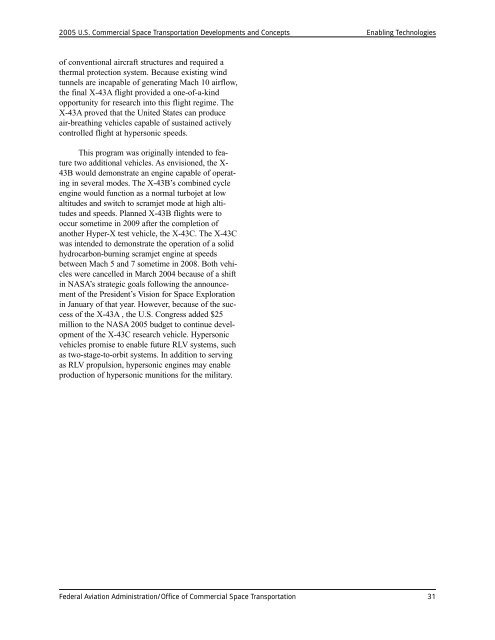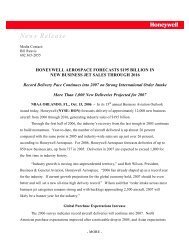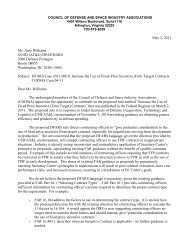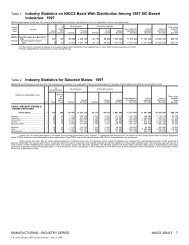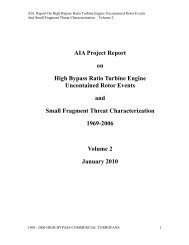2005 U.S. Commercial Space Transportation Developments and Concepts Enabling Technologiesof conventional aircraft structures and required athermal protection system. Because existing windtunnels are incapable of generating Mach 10 airflow,the final X-43A flight provided a one-of-a-kindopportunity for research into this flight regime. TheX-43A proved that the United States can produceair-breathing vehicles capable of sustained activelycontrolled flight at hypersonic speeds.This program was originally intended to featuretwo additional vehicles. As envisioned, the X-43B would demonstrate an engine capable of operatingin several modes. The X-43B’s combined cycleengine would function as a normal turbojet at lowaltitudes and switch to scramjet mode at high altitudesand speeds. Planned X-43B flights were tooccur sometime in 2009 after the completion ofanother Hyper-X test vehicle, the X-43C. The X-43Cwas intended to demonstrate the operation of a solidhydrocarbon-burning scramjet engine at speedsbetween Mach 5 and 7 sometime in 2008. Both vehicleswere cancelled in March 2004 because of a shiftin NASA’s strategic goals following the announcementof the President’s Vision for Space Explorationin January of that year. However, because of the successof the X-43A , the U.S. Congress added $25million to the NASA 2005 budget to continue developmentof the X-43C research vehicle. Hypersonicvehicles promise to enable future RLV systems, suchas two-stage-to-orbit systems. In addition to servingas RLV propulsion, hypersonic engines may enableproduction of hypersonic munitions for the military.Federal Aviation Administration/Office of Commercial Space Transportation 31
Spaceports2005 U.S. Commercial Space Transportation Developments and ConceptsSpaceportsLaunch and reentry sites – often referred to as“spaceports” – are the nation’s gateways to andfrom space. Although individual capabilities vary,these facilities may house launch pads and runwaysas well as the infrastructure, equipment, and fuelsneeded to process launch vehicles and their payloadsbefore launch. The first such facilities in theUnited States emerged in the 1940s when the federalgovernment began to build and operate space launchranges and bases to meet a variety of national needs.While U.S. military and civil governmentagencies were the original and still are the primaryusers and operators of these facilities, commercialpayload customers have become frequent users offederal spaceports as well. Federal facilities are notthe only portals to and from space. Indeed, the commercialdimension of U.S. space activity is evidentnot only in the numbers of commercially procuredlaunches but also in the presence of non-federallaunch sites supplementing federally operated sites.FAA/AST has licensed the operations of fivenon-federal launch sites. These spaceports haveserved both commercial and government payloadowners. Table 2 shows which states have non-federal,federal, and proposed spaceports.This section describes efforts to develop anational space transportation infrastructure plan.The non-federal and federal spaceports capable ofsupporting launch and landing activities that currentlyexist in the United States are also described.A subsection detailing state and private proposalsTable 2: Spaceport Summary by StateState Non-federal Federal ProposedAlabamaAlaskaCaliforniaFloridaKwajaleinNevadaNew MexicoOklahomaTexasUtahVirginiaWashingtonWisconsinfor future spaceports with launch and landing capabilitiesis included.National Coalition of Spaceport StatesIn 2004, the National Coalition of SpaceportStates (NCSS) worked with Federal agencies andCongressional leadership to begin identifying keyconsiderations and laying the groundwork for developinga national space transportation infrastructureplan. This plan is intended to identify all infrastructureelements necessary to support both the emergingprivate enterprise space transportation industryand the new national space exploration initiativeenacted by the President. The plan is intended toprovide a roadmap for establishing non-federalspace infrastructure assets, such as a network ofintermodal spaceports providing bureaucraticallyunfettered access to and from space. The plan willprovide recommendations for streamlining conceptto-operationdevelopment of space transportationinfrastructure from a regulatory standpoint. In additionto spaceport facility development, the plan isexpected to cover other considerations, such asspace traffic control, and federal R&D assistance tonon-federal and private sector space systems efforts.Non-federal Spaceportswith FAA/AST LicensesWhile the majority of licensed launch activity stilloccurs at U.S. federal ranges, much future launchand landing activity may originate from private orstate-operated spaceports. For a non-federal entityto operate a launch or landing site in the UnitedStates, it is necessary to obtain a license from thefederal government through FAA/AST. To date,FAA/AST has licensed the operations of five nonfederallaunch sites, all of which are described inthis subsection. Four of these are co-located withfederal launch sites, including the CaliforniaSpaceport at VAFB, Florida Space Authority (FSA)at Cape Canaveral, Florida, MARS (originally theVirginia Space Flight Center) at WFF, Virginia,Mojave Airport at Mojave, California, and KodiakLaunch Complex at Narrow Cape on KodiakIsland, Alaska. The first orbital launch from anFAA/AST-licensed site occurred on January 6,1998, when a Lockheed Martin Athena 2, carryingNASA’s Lunar Prospector spacecraft, successfully32 Federal Aviation Administration/Office of Commercial Space Transportation


